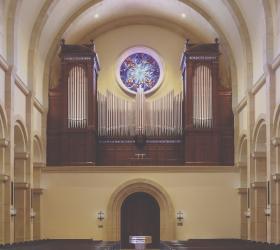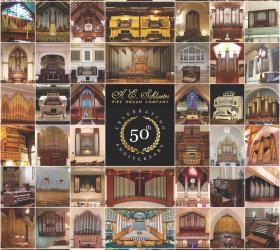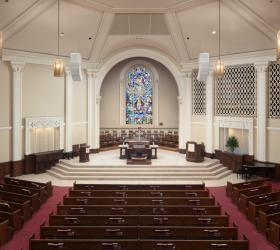
Schoenstein & Co.,
Benicia, California
Dahlgren Chapel,
Georgetown University,
Washington, D.C.
Schoenstein & Co. has built a new organ in the symphonic style for Dahlgren Chapel of Georgetown University in Washington, D.C. The organ of just 16 voices and 19 ranks is an example of distilling the symphonic concept to its essence, providing maximum tonal and dynamic range from a modest stoplist. Half of the instrument’s voices are at 8′ pitch, 25% at 16′, and 25% above 8′. All of the major tonal families are represented, including important solo voices such as the Harmonic Flute, Oboe, Clarinet, and Tuba.
The musical job description for this university organ is quite demanding. In addition to the usual Catholic liturgies, there are many major celebrations (ordinations, baccalaureates, etc.) and a very large number of weddings. The organ is used in various special liturgies as part of the academic program, and it serves the music department as a recital, ensemble, and teaching instrument. Two vital characteristics for success are power and variety. If the organ can’t project an atmosphere of grandeur and doesn’t hold the musical interest of a lot of highly educated people, it will be a failure.
The instrument is a two-manual organ with an additional third manual to access solo stops and a group of ensemble stops along the lines of a Positiv division. The entire instrument with the exception of display pipes is under expression. The Swell includes the Schoenstein double-expression system wherein the high pressure Gambas and Tuba are in a separate expression box located inside the main Swell box. This provides the instrument with an extended dynamic range.
A few stops require some description. The Gamba and Vox Celeste are true strings of keen intonation in contrast to the Salicional, which has some string character but is essentially an Echo Diapason foundational stop. The Tuba in this instrument is a member of the trumpet family—not the dark, sonorous tromba-type. The Corno Dolce is a strongly tapered stop with a mysterious “hybrid” character between flute and string. It is an excellent accompaniment voice and, when extended to the 16′ octave, provides a clean, quick-speaking, pointed bass.
Space always seems to be a concern, especially in a building not originally designed to house an organ. Compact cases were placed on either side of the sanctuary; the 16′ Open Wood Pedal pipes were placed horizontally along the east wall under the window behind a carved and paneled screen. By double-decking the Great and Swell divisions, we were able to keep the casework on either side of the sanctuary quite narrow, thus avoiding the crowding of the huge east end window.
The organ installation was part of a complete chapel renovation and was provided through a grant from the Lewnowski family. The inaugural recital program was played on November 7, 2014, by Lynn Trapp, who also served as consultant for the project. The director of music, liturgy, and Catholic life is James Wickman, who is also the organist.
Schoenstein & Co.
Dahlgren Chapel, Georgetown University, Washington, D.C.
GREAT (Expressive)
16′ Corno Dolce 12 pipes
8′ Grand Open Diapason 61 pipes
(unenclosed)
8′ Open Diapason 61 pipes
8′ Harmonic Flute 42 pipes
(Corno Dolce bass)
8′ Corno Dolce 61 pipes
4′ Principal 61 pipes
4′ Corno Dolce 12 pipes
11⁄3′ Mixture (III–IV ranks) 186 pipes
8′ Tuba Minor (Swell)
8′ Clarinet (TC) 49 pipes
Tremulant
Chimes
Great Unison Off
Great 4
SWELL (Expressive)
16′ Bourdon 12 pipes
8′ Salicional 61 pipes
8′ Stopped Diapason 61 pipes
8′ Gamba† 61 pipes
8′ Vox Celeste† 61 pipes
4′ Salicet 12 pipes
4′ Chimney Flute 61 pipes
22⁄3′ Nazard (from Chimney Flute)
2′ Fifteenth (ext Salicet) 12 pipes
13⁄5′ Tierce (TC) 42 pipes
16′ Bass Tuba† 12 pipes
8′ Tuba Minor† 61 pipes
8′ Oboe 61 pipes
Tremulant
Swell 16
Swell Unison Off
Swell 4
†Stops under double expression
SOLO
Solo Stops
8′ Grand Open Diapason (Great)
8′ Open Diapason (Great)
8′ Harmonic Flute (Great)
8′ Clarinet (Great)
8′ Oboe (Swell)
16′ Bass Tuba (Swell)
8′ Tuba Minor (Swell)
Ensemble Stops
8′ Stopped Diapason (Swell)
4′ Salicet (Swell)
4′ Chimney Flute (Swell)
22⁄3′ Nazard (Swell)
2′ Fifteenth (Swell)
13⁄5′ Tierce (Swell)
Percussion Stops
Harp (Digital)
Celesta (Digital)
Cymbelstern (Acoustic)
Solo 16
Solo Unison Off
Solo 4
PEDAL (Unenclosed)
32′ Resultant
16′ Open Wood 12 pipes
16′ Corno Dolce (Great)
16′ Bourdon (Swell)
8′’ Principal 20 pipes
(Grand Open Treble)
8′ Salicional (Swell)
8′ Stopped Diapason (Swell)
8′ Corno Dolce (Great)
4′ Fifteenth (Great)
(from Grand Open)
4′ Flute (Great)
(from Harmonic Flute)
16′ Bass Tuba (Swell)
8′ Tuba Minor (Swell)
4′ Clarinet (Great)
Couplers
Great to Pedal
Great to Pedal 4
Swell to Pedal
Swell to Pedal 4
Solo to Pedal
Solo to Pedal 4
Swell to Great 16
Swell to Great
Swell to Great 4
Solo to Great 16
Solo to Great
Great to Solo
Swell to Solo
Great to Swell
Mechanicals
Solid state capture combination action with:
100 Memories
35 Pistons and toe studs
6 Reversibles including Full Organ
Programmable piston range for each memory level
Programmable Crescendo and Full Organ
Piston Sequencer
Adjustable bench
Three manuals and pedal
16 voices, 19 ranks
Electric-pneumatic action




